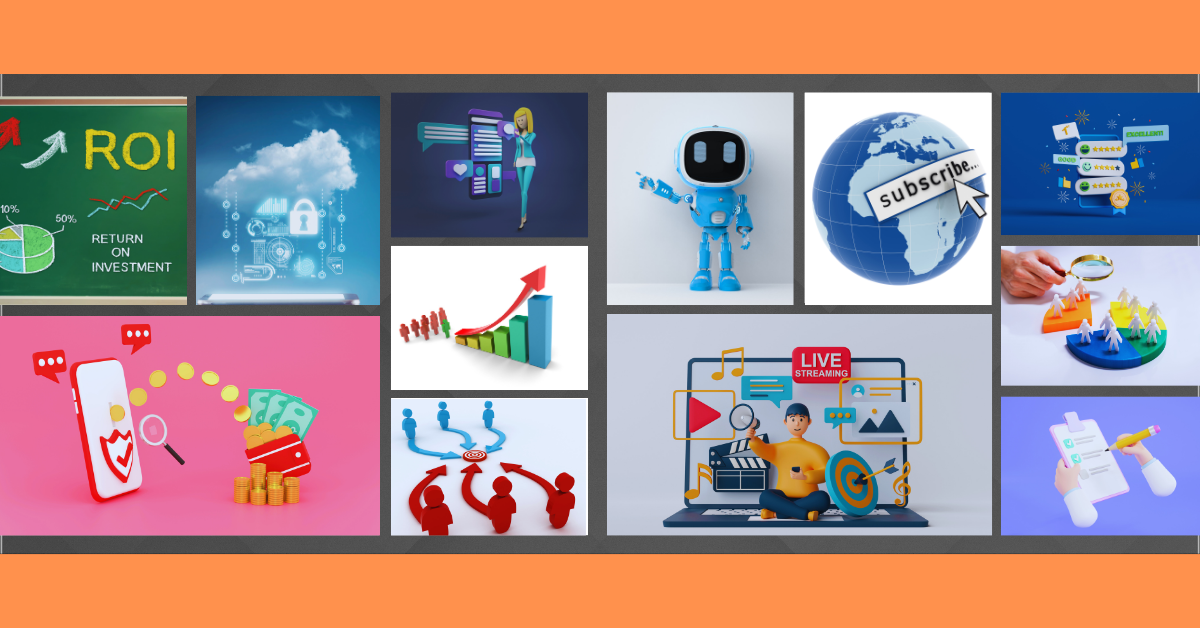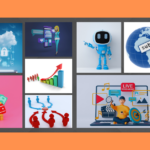This article contains affiliate links – but that doesn’t mean this piece is an ad.
All content is our honest take on the service/product and incorporates our
real thoughts and experience using it.
Welcome to 2024. It’s a great year bursting with potential for startups in the SaaS (Software as a Service) space.
Understanding the latest trends and data is critical to a startup’s success. For example, it’s estimated that 75% of internet users will be mobile-exclusive by 2025. So, mobile-first development has become a priority.
Let’s illuminate what the numbers are saying right now. We’ll get into those numbers and key SaaS marketing statistics you should know heading into the new year.
One-person army SaaS startup? Established player looking to remain competitive? Either way, buckle up for an enlightening journey through the data that could shape your new strategy.
Table of Contents
SaaS Marketing Statistics – A Global Market Growth Snapshot

According to a report by Statista, the global SaaS market is worth nearly $200 billion. Next year? Expect to see that figure go up to more than $230 billion.
The increasing demand for cloud-based software solutions contributes heavily to this staggering growth. The rise of digital transformation across various industries also plays a part.
More businesses look to SaaS for its cost-effectiveness and scalability. Even startup funding in 2024 looks promising. So, we should see the market continue its upward trajectory.
Let’s talk about some more statistics you should be watching.
The Average SaaS Growth Rate
Chart Mogul found the monthly average SaaS growth rate to be around 2% over the course of the product’s life cycle. While this doesn’t seem like much, it’s a staggering number.
Considering a pending recession hanging over our heads for the last two years and many companies cracking down on overhead after the pandemic, SaaS is one of the only industries still seeing this kind of growth.
SaaS Marketing Spend
How much you spend on marketing will depend on where you are in the business cycle.
Young startups usually have a SaaS marketing spend of nearly 100% of revenue. Why? You have a product and you need people talking about it. You have to get the word out. People need to know who you are and what you do.
Enterprise-level companies spend closer to 5-10% of revenue on marketing. They have bigger fish to fry at this point. They’re buying up other companies, investing in new products, and pushing the bar to stay on top.
SaaS Marketing Statistics – The Power of Social Media
Some of the most powerful SaaS 2023 marketing statistics are from social sites. Social media has become an integral part of our lives. It’s not going away anytime soon.
There are eight billion people in the world, and more than half of them are using social media regularly. And these regular users spend nearly three hours daily on the platforms.
We talk a lot about going where your customers are. This is where you’ll find them.
This presents a significant opportunity for SaaS startups. Use social channels to connect with potential customers, build brand awareness, and drive conversions.
The Importance of Personalization in SaaS Marketing
Consumers no longer want a personalized experience. They demand it. If you don’t deliver, someone else will.
Nearly 60% of consumers say they will give a company repeat business if they have a personalized experience.
The competition, according to SaaS marketing statistics, is only going to increase. Providing personalized solutions and experiences will become critical for startups to stand out and keep customers.
The Impact of Video Marketing on SaaS Conversions
SaaS Video marketing is a potent tool for SaaS companies to engage and convert leads.
According to a report by HubSpot, 92% of marketers who use video say they receive a high ROI for the effort.
In 2024, we can expect to see even more SaaS startups utilizing videos to showcase their product, educate their audience, and increase conversions.
Video Marketing: Where Influencers Shine
Influencer marketing for SaaS startups will help you reach new audiences and build credibility.
Why? A few reasons.
It’s content from someone who has a following of people. This following is made up of people who trust the influencer. Trusted followers buy things the influencers promote.
Secondly, people can see with their own eyes how to use the product. Influencers can record tutorials and go into detail about the solutions your product provides.
Customer Acquisition Cost (CAC): The Numbers You Need to Know
Customer acquisition cost (CAC) is a crucial metric for SaaS startups. It’s a metric representing the money spent on acquiring a single customer.
Your CAC will depend on several factors. One of the biggest is your chosen sector. First Page Sage found that most SaaS companies have a little over $2 CAC. They then broke this down by the type of market.
Going after a small business isn’t going to cost you much. But it isn’t going to make as much, either. Conversely, catering to enterprise-level companies will cost you more to bring them in but have substantially higher returns.
In 2024, we can expect this number to continue rising, making it critical for startups to optimize their marketing efforts and customer retention strategies.
The Power of Customer Reviews and Testimonials
Customer reviews and testimonials contribute to a startup’s success. Especially in a highly competitive market like SaaS.
Word-of-mouth marketing, referral strategies, and influencer marketing can help keep your CAC low and bring in hotter leads.
Most SaaS companies rely on a subscription-based model, so these methods help ease the CAC burden.
Harnessing the Power of Customer Lifetime Value (CLV)
Another crucial metric in the SaaS marketing statistics for startups is the customer lifetime value (CLV). It’s usually mentioned in the same conversations as CAC, as they are closely correlated.
It represents the total revenue a business can expect from a single customer over their entire relationship.
SaaS companies usually expect a 24-month lifespan. But seeing 48 months isn’t unheard of in the space. Anything more than four years is fantastic. So, if you’re averaging $50 a month per customer, with a lifespan of two years, your CLV should be $1200.
Given the CAC of many customers for SaaS startups is around $2, that’s not too shabby.
The Growing Importance of User Experience (UX)
User experience (UX) design has become integral to SaaS product development, with companies investing heavily in creating seamless and intuitive user experiences.
According to User Guiding, 88% of customers won’t return to a website if they have a bad user experience.
SaaS startups should continue prioritizing UX as a key differentiator and driver of customer satisfaction and retention.
Churn Rates: What They Mean for Your Startup
The churn rate is the percentage of customers who cancel their subscriptions or stop using a service within a given period.
According to a report by Baremetrics, the average churn rate for SaaS companies in 2023 was around 5%. We typically see higher and lower rates for smaller businesses for larger enterprises.
High churn rates significantly impact a startup’s growth and profitability. Companies should focus on customer satisfaction and retention strategies to keep it low.
SaaS Content Marketing Statistics

Knowing SaaS content marketing statistics has become a key strategy for startups. They know it’s the cheat code to attract potential customers and keep the ones they have.
According to Single Grain, nearly 70% of consumers read about brands that interest them.
Translation: You need to provide words for people to read. It has to have value. And you have to promote it on social channels.
With the SaaS market becoming increasingly competitive, producing high-quality and relevant content will continue to be a valuable way for startups to drive brand awareness.
Use it to establish thought leadership and attract potential customers.
The Importance of Data-Driven Marketing in SaaS
Data-driven marketing has become essential for SaaS companies looking to optimize their strategies and succeed.
With so much abundant data, there is no reason SaaS startups shouldn’t invest in the proper tools and processes for collection and analysis.
Pay attention to the numbers. Especially when it comes to SEO, email marketing, and SaaS social media marketing. They’ll help guide you. They’ll tell you how to adjust content creation and promotion.
Understanding Annual Recurring Revenue (ARR) Statistics
Annual recurring revenue (ARR) is a key metric for SaaS startups. It’s the predictable and recurring revenue stream from customers’ annual subscriptions.
According to Vena, the average ARR growth rate in the SaaS industry is 3%. Some top-performing companies are seeing higher growth rates.
In 2024, we expect to see continued growth in ARR as more businesses embrace the subscription-based model. ARR is quickly becoming an essential metric for SaaS startups to track and optimize.
Account-Based Marketing (ABM) in SaaS
Account-based marketing (ABM) has become a popular strategy for B2B SaaS companies to effectively target and engage high-value accounts.
If one company makes up 25%, shouldn’t you cater to them? It makes sense, right? You want your sales team to be on a first-name basis with their decision-makers. Take them to dinner. Buy them drinks.
SaaS startups will likely continue adopting ABM as a key strategy for targeting and winning over enterprise clients.
The Role of Artificial Intelligence (AI) in SaaS Marketing
It wouldn’t be a SaaS blog post without mention of AI, would it?
Artificial intelligence (AI) has become a game-changer for SaaS companies. It enables them to automate processes, personalize experiences, and make data-driven decisions.
Techopedia reports that over 80% of SaaS businesses are using AI. Nearly all those who aren’t are planning to by the end of 2024.
As the use of AI in marketing continues to grow, SaaS startups must embrace and leverage this technology to stay ahead. It’s no longer about an edge. It’s now a must-have.
SaaS Marketing Statistics – Learn and Apply to Your Business
SaaS marketing statistics are driven by key factors such as the importance of data-driven marketing and SaaS marketing spend. Put a focus on KPIs mentioned today – such as churn rate, CLV, and CAC.
As competition intensifies, startups need to remain agile, leverage the power of innovative technologies, and prioritize customer success to drive growth. Keep an eye on SaaS content marketing statistics to stay on top of what’s working in your industry.
Moreover, understanding the average SaaS growth rate will help you know where your business is right now.
Consider these statistics and insights to strategize effectively and position yourself for success in the future.





Thank you for your sharing. These numbers actually make me optimistic for the future of SaaS.
We’re happy to hear that! It’s important to have an optimistic perspective on the projected growth of your industry!
Hi there! I just wanted to say that this was a very interesting read, thanks for sharing it with us. I look forward to your next articles.
Happy to hear that! We look forward to having you back, stay tuned!
There are some eye-openers in this post. I am excited to delve deeper into the stats as it aligns perfectly with my passion for learning.
Enjoy the rabbit hole!
I definitely have my work cut out for me. Thank you for sharing!
It’s not an easy market to break into, but with a sought-after product (and after quite extensive research), we have seen that it’s definitely possible.
This article breaks down the numbers to make it easier to understand where the market is at. Thank you for sharing.
It is our pleasure!